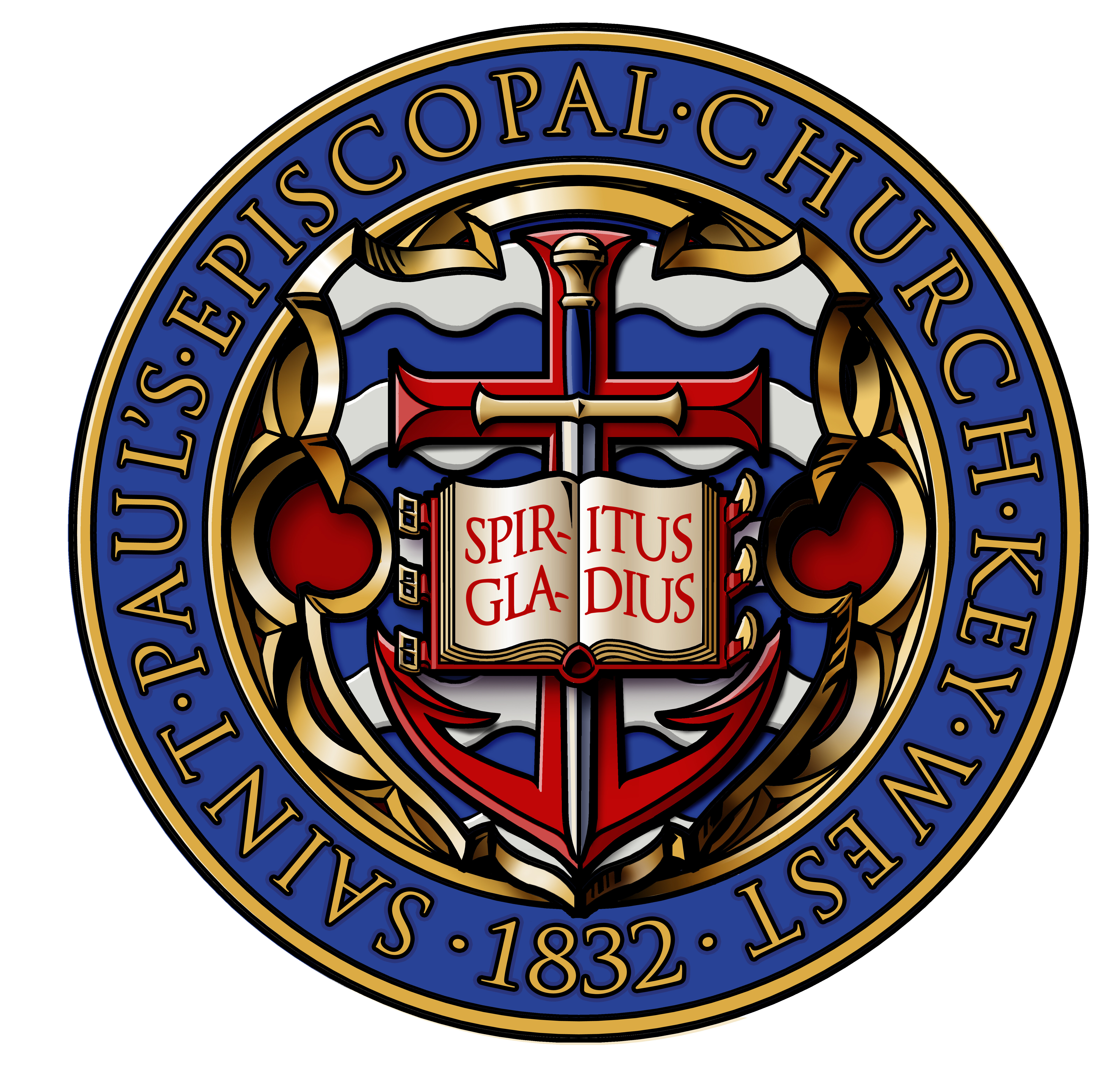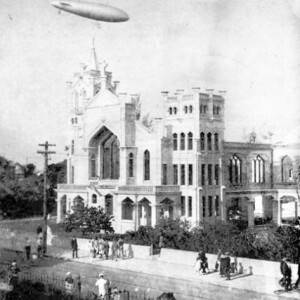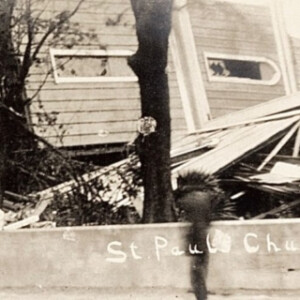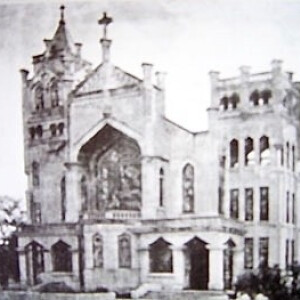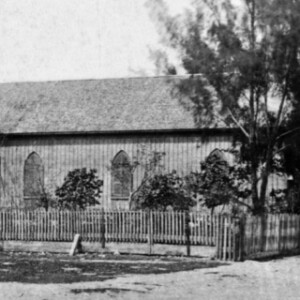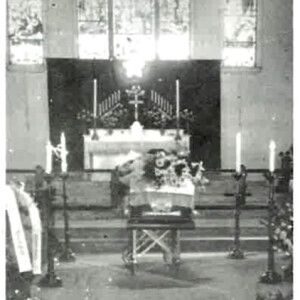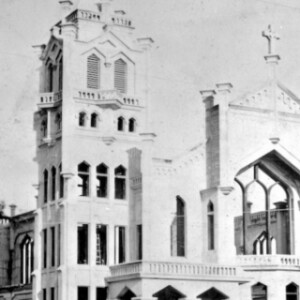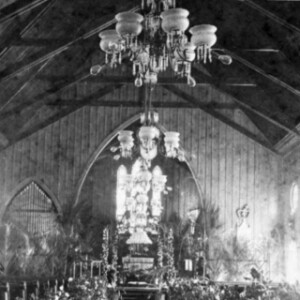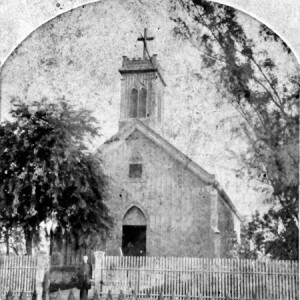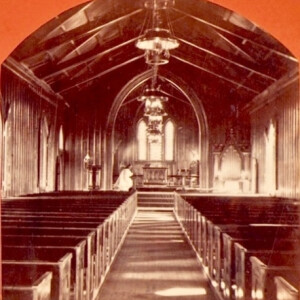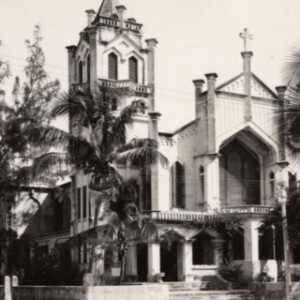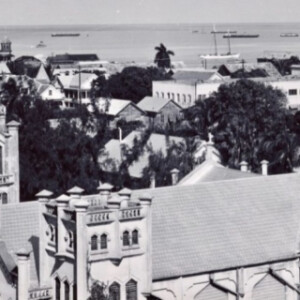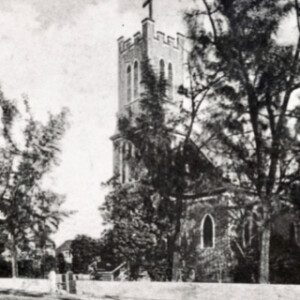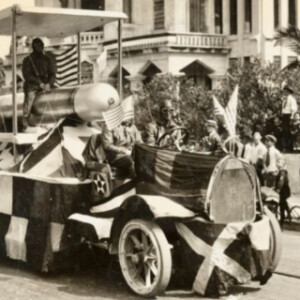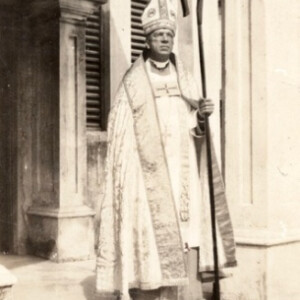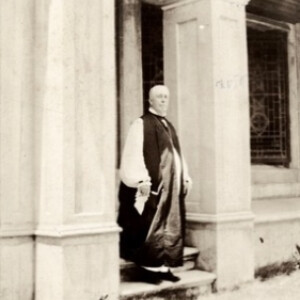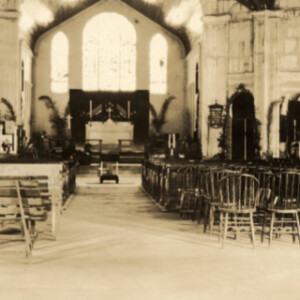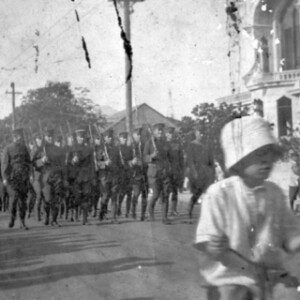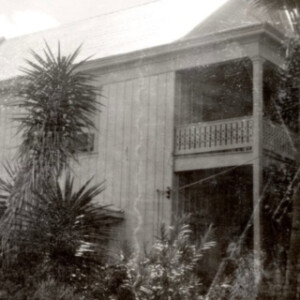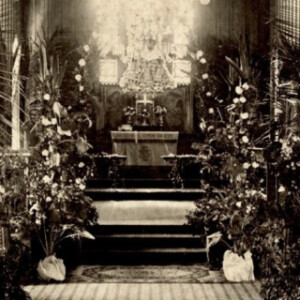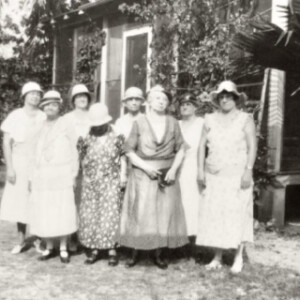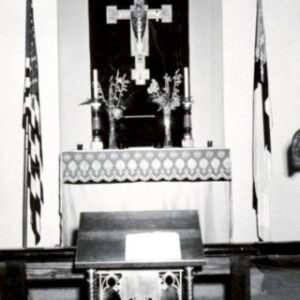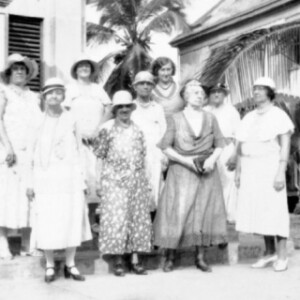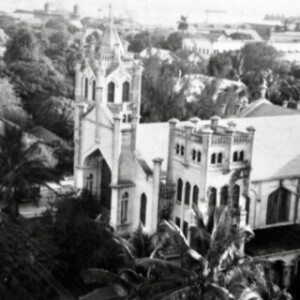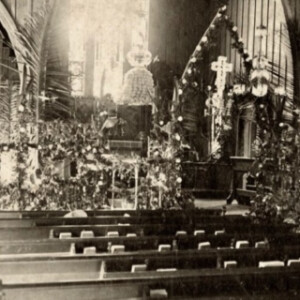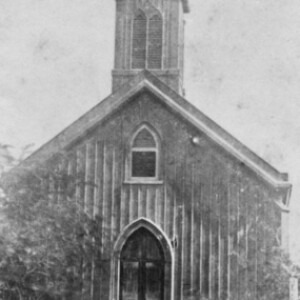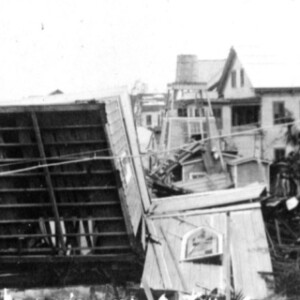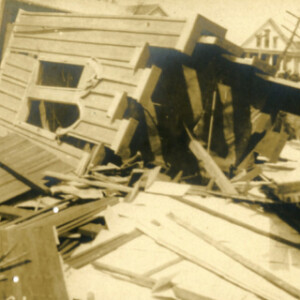St Paul’s Church was formed by an official act of the City Council of Key West. In a petition to the bishop of New York, the city council requested a priest be sent and the Parish of St. Paul’s be established. In 1831, the council gave notice of a public meeting to establish an Episcopal Church, and a committee was appointed.
The first rector was the Reverend Sanson K. Brunot, who arrived December 23, 1832. He held the first service on Christmas Day 1832 in the County Courthouse on Jackson Square. That same day the congregation signed an “Act of Association” of the Episcopal Congregation in Key West to be called St Paul’s Church.
The first Vestry was elected April 8, 1833, and the Reverend Brunot became a permanent house guest of Vestryman William Whitehead, as there was no rectory or church building. Land for a church site was given by the widow of John William Charles Fleming in 1832 with the only stipulation that her husband’s remains stay where they were. He is still buried on the grounds, but the actual site is unknown.
The original church made of coral rock, was built in 1838-39. The building, when completed, was 38 x 58 feet, and the total cost of construction was $6,500. This first building was totally destroyed by a hurricane on October 11, 1846. The second church was a wooden structure measuring 28 x 66 feet. Services were first held in this building on June 30, 1848, and the church was consecrated on January 4, 1851, by the Right Reverend C.E. Gadsden, Bishop of South Carolina.
In 1857 a rectory was erected on the corner of Duval and Eaton Street, facing Eaton. The Reverend Osgood E. Herrick was the first in a long line of rectors to call it home. The church was growing steadily, and the seating capacity of 350 was becoming inadequate. This is when St Peter’s was established (1875), and the Spanish Mission of St John’s followed.
The second church was destroyed in the Great Fire of Key West in March 1886. By some good fortune the rectory survived undamaged. Rebuilding the church began immediately, and the third church was completed in 1887. Constructed of wood, it stood in the center of the block with the doors facing Eaton Street. It measured approximately 58 x 98 feet.
In 1890, the Vestry voted to purchase a chime of bells. Once installed, the first chime of bells in Florida was inaugurated on Palm Sunday morning, March 22, 1891, at 10:00 am.
On October 11, 1909, another disaster struck, and the church was destroyed by a hurricane. The parish hall (completed in 1904) and the rectory survived the storm and were used for services. Plans for a new church, which would be constructed of concrete, were approved in 1911. The church would be located at the corner of Duval and Eaton Streets. This required the moving of the rectory to its current location in 1914. The first service in the current building was held June 8, 1919. During this time, many of the beautiful stained-glass windows were ordered, and installation began in 1920. The organ arrived in 1931 in time for Christmas services.
A major restoration of the current church building began in 1991 to save the building from collapse. The concrete used in the initial construction had been mixed with seawater and beach sand, causing the steel reinforcing within the walls and columns to split. Work was completed in 1993 at a cost of nearly one million dollars.
In the 2020s, over a century into its life, the historic nave of St Paul’s is again in need of a major restoration. The first chime of bells in Florida is silent because both the bell tower and the platform upon which the bells rest are structurally unsound. The historic rectory and the parish hall are also in need of significant restoration and repair.
This oldest US congregation south of St Augustine has been served by dozens of priests throughout almost two centuries. The thirty-fourth rector of St Paul’s is the Very Reverend Donna S. Mote, PhD, who began her tenure June 5, 2021.
The church building and grounds at the corner of Duval and Eaton Streets are open daily for prayer, meditation, and visitation. As a beautiful and beloved venue for concerts and community events as well as worship, St Paul’s is an iconic and historic community asset stewarded by the congregation for the enrichment and enjoyment of everyone, now and always, in the heart and the hearts of Key West.
Our History
Vintage Photos of St. Paul's
In February 2020, St. Paul's celebrated the 100th anniversary of the current church building, the fourth on the same site. As part of the centennial events, a digital gallery of vintage church photos was created. Photos include the rectory, three of the four churches, some as early as the civil war, bishops, priests, and ordinary parishioners from days long past. If you have vintage photos of St. Paul's to share, please email scans with captions to editor@stpaulskeywest.org. To navigate the below gallery, scroll down and click on a selection. Use keyboard or embedded arrows to advance.
History Q&A
To stimulate interest in the 2020 centennial celebration of the completion of the third church on our site, we published a series of history questions and answers in the church newsletter, "The Epistle". Thanks to parishioner and church historian David Eyer for supplying the questions and answers.
Q. What is the reason the sanctuary has so many cracks in the concrete?
A. It is commonly said that beach sand was used in preparing the concrete placed in the church. It is not known where the aggregate used to make the St Paul’s concrete was sourced. If it was excavated anywhere in the Keys, it would have been from a saltwater environment. This aggregate can be used successfully provided it is thoroughly washed in fresh water to remove the chloride ions. Fresh water was expensive during the time of the Overseas Railroad and church construction. The railroad brought fresh water with them in tank cars as the line was extended to Key West. Also, most of the concrete placed for the Overseas Railroad is in pure compression and little or no steel reinforcing was used. St Paul’s is different and due to the loading and square architectural shapes and openings, steel reinforcing was required in most areas of the building. Poor aggregate washing caused chloride ions to remain that caused the reinforcing steel to rust. When steel reinforcing rusts it expands with enormous force causing the surrounding concrete to crack. This is called spalling. This admits salt laden air into the concrete permitting a continual addition of chloride ions to the steel causing more rust. Also - it appears there are no expansion joints for the concrete. Calculations show the south wall of the church lengthens up to 3/8” on a hot summer day in contrast to the shaded Eaton St side.
Q. What is your best best guess as to the age of the very large mahogany tree in the St. Paul's Memorial Garden?
A. We do not know exactly, but based on some available information, one can make an educated guess. Late parishioner Leon W Sands reported that he remembered when the tree was planted when he was a boy. Leon lived from about 1920 to 2005. He was a prominent realtor and Mason. He would have been a boy likely to remember a tree planting in the early 1930s. When w e look at a great tree such as we have, it is easy to under or overestimate its age by decades. A mahogany tree more than two years old is already too large to plant or transplant without special equipment that was probably not available in Key West at the time. Our mahogany most likely began to grow about 1930 making it about 90 years old at the max.
Q. What local flowers were most commonly used at St Paul’s Church from the 1830s to about the 1920s?
A. Although there are photos showing large arrangements of non-local flowers for planned occasions such as weddings that included white roses, the Desert Rose (adenium obesum) seems to be the most commonly used flower for normal service use. It is easily grown and has a beautiful pink flower. It is more closely related biologically to the frangipani than true roses. It is native to Africa and the Middle East.
Q. This month's history question refers to the little known "lantern tower", an important feature of the architect's original 1911-12 plan for the current church. What and where was the mysterious lantern tower?
A. The lantern tower was a massive wooden structure mimicking the concrete bell tower in size and appearance. The center point of the lantern tower was directly above the center point of the crossing of the church. The top of the lantern tower was the same height above ground level as the bell tower. It is not known if the lantern tower was actually constructed. It seems likely it was constructed simultaneous with the roof in 1918-9 and then destroyed with much of the roof months later in the 1919 Hurricane. No photo has been found with the lantern tower in place. If you have seen such a photo- please copy it with your smart phone and send to the church office.
Q: Where and when was the St Paul’s Cuban Tile made, who designed it and who laid it?
A: As discussed in the last issue, Cuban Tile is made from cement. It cannot be fired like clay tile. It is incredibly durable. Our tiles were designed by Key West artist and St Paul’s parishioner Gene Otto who lived in what has become known as the Artist House B&B between St Paul’s and the Key West United Methodist Church on Eaton St. Otto was also famous as the owner of “Robert the Doll” (see the fascinating story of this "evil" doll here). Otto was known as "Green Gene” because of his frequent use of the color green in his work. It is a wonder we do not have a green floor. The floor tiles were produced in Miami about 1960.
The tile was laid by Key West tile setter Juan Torres and an assistant. Juan reported on the hot, hard work laying the tile because the church was not yet air conditioned. Each St Paul's tile is unique from the others, like snowflakes, and weighs about 100 pounds. The tile was laid before tile setting “thin set” was developed. The St Paul's tile is set in a special type of cement well more than an inch thick. The total thickness of the tile and bedding cement is more than three inches which can be seen fully at the nave entrance to the choir room.
Q: What is the material on the St Paul’s Church floor and when was it installed?
A: The floor covering is Cuban tile and was installed in 1960. It is made upside down in a mold - like a pineapple upside down cake. The pigment is in a powder form and goes in the mold first. There can be free form or geometric patterns. The St Paul’s tile has two additional layers of cementitious material. The large tiles on the main floor are about 2” thick and each weigh about 100 pounds. The tiles contain no clay so they cannot be fired. They are pressed to conform to the mold. Cuban Tiles are very durable. The tiles in front of the baptistry on the Duval St end of the church have had about 15,000,000 sets of footsteps from visitors and parishioners since installation.
Q: When and for which of the 4 St. Paul's churches was our chime of bells produced? Separate from St. Paul's, what is the recent and very important commission the bell foundry received?
A: Our chime of bells was produced by the McShane Bell Foundry of Baltimore, Md for the 3rd St. Paul's church and delivered by boat in 1891. The hurricane of October 11th, 1909 destroyed the 3rd church but the bells were saved and reused in the 4th St. Paul's in 1919. Established in 1856, the McShane Bell Foundry is still in operation and received the commission to produce the commemorative bells for the three September 11, 2001, Memorial locations: The World Trade Center; The Pentagon; and The Flight 93 crash site near Shanksville, PA
Q: What is the sad story of the origin of the statue of the Blessed Mother with Child (Mary holding the infant Jesus) located near the Lady Chapel?
A: It is a memorial to a mother and daughter who were members of St Paul’s Church and who died in the 1935 Labor Day Hurricane while visiting in the Islamorada area. Both were named Mary Ingraham, and both were school teachers. There were other members of the Ingraham family who also died in this tragic event. The hurricane caused little damage in Key West, but it devastated the Upper Keys including destroying miles of track of the Overseas Railroad. The tracks were restored to a limited extent in order to get locomotives and rail cars out of Key West and back to the mainland. The hurricane ended service on the railroad, which interestingly was already in bankruptcy proceedings prior to the hurricane.
Q: What Oscar winning film had about five minutes of scenes at St. Paul’s?
A: Winner of 3 Oscars, the 1955 film, The Rose Tattoo was based on the play of the same name by Tennessee Williams, a St Paul’s parishioner at the time. The setting of the story was coastal Louisiana but much of the movie was actually filmed in Key West. The filmmaker reportedly wanted a very proper appearing Roman Catholic Church and St Paul’s fit the bill more so than our local RC St Mary’s Star of the Sea.
Q: Where did the largely Roman Catholic Cuban cigar making families of the 1880-1905 era worship? They were one of the largest ethnic groups of the city then as are their descendants today.
A: In a parish they called St John’s (not San Juan) that was at and part of St Paul’s Church. Until 1903, St Mary’s RC Church was across Duval St from St Paul’s. The Cubans regarded the Roman Catholic Church to be a tool of the Spanish government and refused to go there. Cuba was part of Spain until the Spanish American War of 1898. The St John’s genealogical records are part of the records of St Paul’s Church.
Q: What role did the wife and widow of prominent Key West founder, William Fleming, play in establishing St. Paul's and what strings were attached?
A: Mary Rotch, by then re-married, gave the current lot to the newly established St Paul’s Parish in 1838 with the proviso that the pews be free - no family-owned pews as was common at the time. She also stipulated that her deceased husband's remains, which had by then been buried on the property, were to be undisturbed on the grounds forever. Their location is unknown.
Q: When and where was the first service held by the first rector, Rev. Sanson K. Brunot?
A: Two days after his Dec 23rd arrival in Key West, Rev. Brunot held the first service, Christmas Day, 1832. As there was no church, the service was held at the County Courthouse on Jackson Square. That same day the congregation signed an “Act of Association” of the Episcopal Congregation in Key West to be called St. Paul’s Church.
Q: Who was the first rector of St. Paul's and what is his sad story?
A: The Reverend Sanson K. Brunot of Pittsburgh, PA was the first rector. He arrived in Key West December 23rd and soon became the house guest of vestryman William Whitehead as there was no rectory or church building. He was only 24 years old and had not been long in ministry. His services were well attended, and he was generally well liked. He had accepted the call to Key West largely on account of his ill health, hoping the climate would lead to an improvement. Unfortunately, Rev. Brunot's health soon began to fail and after officiating only a few times, frequent hemorrhages put a stop to further public services. Feeling that his end was approaching and desiring to pass his last days in his old home, he left Key West for Pittsburgh in May 1833 and died there soon after his arrival.
Q: When and how was St. Paul's Episcopal Church founded?
A: It was established by an act of the Town of Key West Council in 1831. At that time there was no church property much less a structure, a pastor or priest, or even a congregation. In fact, there were no churches at all in Key West of any denomination.
